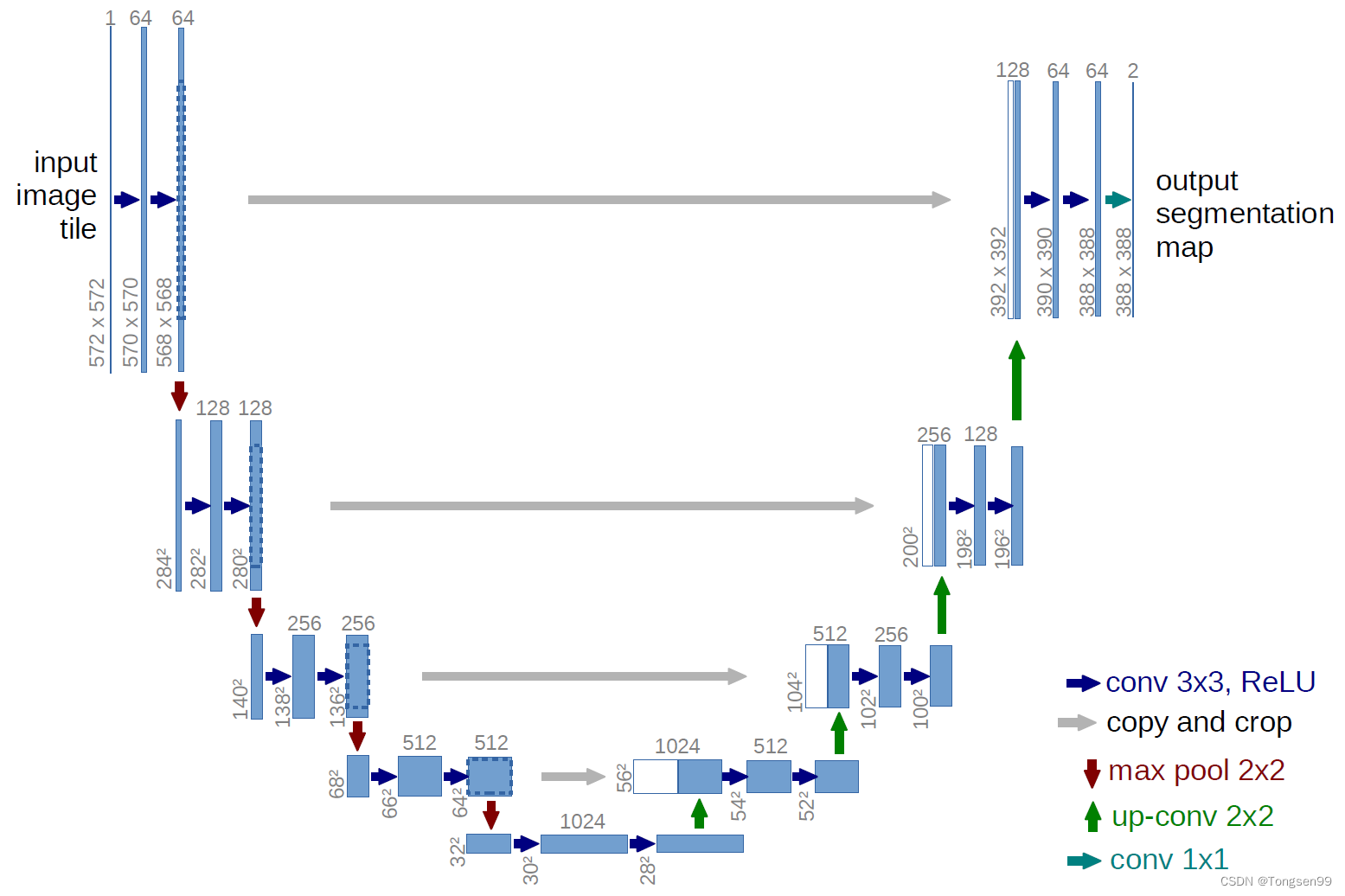文章目录
导库
import os
import torch
import torch.nn as nn
import torch.nn.functional as F
import torchvision
import collections
from collections import OrderedDict
PyTorch模型定义的方式
Sequential
当模型的前向计算为简单串联各个层的计算时, Sequential 类可以通过更加简单的方式定义模型。它可以接收一个子模块的有序字典(OrderedDict) 或者一系列子模块作为参数来逐一添加 Module 的实例,?模型的前向计算就是将这些实例按添加的顺序逐?计算。
直接排列
net = nn.Sequential(
nn.Linear(784, 256),
nn.ReLU(),
nn.Linear(256, 10),
)
print(net)
使用OrderedDict
net = nn.Sequential(collections.OrderedDict([
('fc1', nn.Linear(784, 256)),
('relu1', nn.ReLU()),
('fc2', nn.Linear(256, 10))
]))
print(net)
- 使用Sequential定义模型的好处在于简单、易读,同时使用Sequential定义的模型不需要再写forward,因为顺序已经定义好了。
- 但使用Sequential也会使得模型定义丧失灵活性,比如需要在模型中间加入一个外部输入时就不适合用Sequential的方式实现。使用时需根据实际需求加以选择。
ModuleList
ModuleList 接收一个子模块(或层,需属于nn.Module类)的列表作为输入,然后也可以类似List那样进行append和extend操作。同时,子模块或层的权重也会自动添加到网络中来。
net = nn.ModuleList([nn.Linear(784, 256), nn.ReLU()])
net.append(nn.Linear(256, 10)) # 类似List的append操作
print(net[-1]) # 类似List的索引访问
print(net)
- nn.ModuleList 并没有定义一个网络,它只是将不同的模块储存在一起。ModuleList中元素的先后顺序并不代表其在网络中的真实位置顺序,需要经过forward函数指定各个层的先后顺序后才算完成了模型的定义。
class model(nn.Module):
def __init__(self, ...):
super().__init__()
self.modulelist = nn.ModuleList([nn.Linear(784, 256), nn.ReLU()])
self.modulelist.append(nn.Linear(256, 10))
def forward(self, x):
for layer in self.modulelist:
x = layer(x)
return x
ModuleDict
ModuleDict和ModuleList的作用类似,只是ModuleDict能够更方便地为神经网络的层添加名称。
net = nn.ModuleDict({
'linear': nn.Linear(784, 256),
'act': nn.ReLU(),
})
net['output'] = nn.Linear(256, 10) # 添加
print(net['linear']) # 访问
print(net.output)
print(net)
- 同样的,nn.ModuleDict 并没有定义一个网络,它只是将不同的模块储存在一起。
利用模型块快速搭建复杂网络
U-Net简介
U-Net是分割 (Segmentation) 模型的杰作,在以医学影像为代表的诸多领域有着广泛的应用。U-Net模型结构如下图所示,通过残差连接结构解决了模型学习中的退化问题,使得神经网络的深度能够不断扩展。

U-Net模型块分析
组成U-Net的模型块主要有如下几个部分:
- 每个子块内部的两次卷积(Double Convolution)。
- 左侧模型块之间的下采样连接,即最大池化(Max pooling)。
- 右侧模型块之间的上采样连接(Up sampling)。
- 输出层的处理。
- 除模型块外,还有模型块之间的横向连接,输入和U-Net底部的连接等计算,这些单独的操作可以通过forward函数来实现。
U-Net模型块实现
class DoubleConv(nn.Module):
"""(convolution => [BN] => ReLU) * 2"""
def __init__(self, in_channels, out_channels, mid_channels=None):
super().__init__()
if not mid_channels:
mid_channels = out_channels
self.double_conv = nn.Sequential(
nn.Conv2d(in_channels, mid_channels, kernel_size=3, padding=1, bias=False),
nn.BatchNorm2d(mid_channels),
nn.ReLU(inplace=True),
nn.Conv2d(mid_channels, out_channels, kernel_size=3, padding=1, bias=False),
nn.BatchNorm2d(out_channels),
nn.ReLU(inplace=True)
)
def forward(self, x):
return self.double_conv(x)
class Down(nn.Module):
"""Downscaling with maxpool then double conv"""
def __init__(self, in_channels, out_channels):
super().__init__()
self.maxpool_conv = nn.Sequential(
nn.MaxPool2d(2),# 2代表kernel_size
DoubleConv(in_channels, out_channels)
)
def forward(self, x):
return self.maxpool_conv(x)
class Up(nn.Module):
"""Upscaling then double conv"""
def __init__(self, in_channels, out_channels, bilinear=True):
super().__init__()
# bilinear(双线性插值)是一种插值方式
# if bilinear, use the normal convolutions to reduce the number of channels
if bilinear:
self.up = nn.Upsample(scale_factor=2, mode='bilinear', align_corners=True)
self.conv = DoubleConv(in_channels, out_channels, in_channels // 2)
else:
self.up = nn.ConvTranspose2d(in_channels, in_channels // 2, kernel_size=2, stride=2)
self.conv = DoubleConv(in_channels, out_channels)
def forward(self, x1, x2):
x1 = self.up(x1)
# input is CHW
diffY = x2.size()[2] - x1.size()[2]
diffX = x2.size()[3] - x1.size()[3]
x1 = F.pad(x1, [diffX // 2, diffX - diffX // 2,
diffY // 2, diffY - diffY // 2])
x = torch.cat([x2, x1], dim=1)# torch.cat实现了tensor的拼接
return self.conv(x)
class OutConv(nn.Module):
def __init__(self, in_channels, out_channels):
super(OutConv, self).__init__()
self.conv = nn.Conv2d(in_channels, out_channels, kernel_size=1)
def forward(self, x):
return self.conv(x)
利用模型块组装U-Net
class UNet(nn.Module):
def __init__(self, n_channels, n_classes, bilinear=True):
super(UNet, self).__init__()
self.n_channels = n_channels
self.n_classes = n_classes
self.bilinear = bilinear
self.inc = DoubleConv(n_channels, 64)# 输入层
self.down1 = Down(64, 128)
self.down2 = Down(128, 256)
self.down3 = Down(256, 512)
factor = 2 if bilinear else 1
self.down4 = Down(512, 1024 // factor)
self.up1 = Up(1024, 512 // factor, bilinear)
self.up2 = Up(512, 256 // factor, bilinear)
self.up3 = Up(256, 128 // factor, bilinear)
self.up4 = Up(128, 64, bilinear)
self.outc = OutConv(64, n_classes)# 输出层
def forward(self, x):
x1 = self.inc(x)
x2 = self.down1(x1)
x3 = self.down2(x2)
x4 = self.down3(x3)
x5 = self.down4(x4)
x = self.up1(x5, x4)
x = self.up2(x, x3)
x = self.up3(x, x2)
x = self.up4(x, x1)
logits = self.outc(x)
return logits
PyTorch修改模型
修改模型层
import torchvision.models as models
net = models.resnet50()# torchvision预定义好的模型ResNet50
print(net)
假设我们要用这个resnet模型去做一个10分类的问题,就应该修改模型的fc层,将其输出节点数替换为10。另外,我们觉得一层全连接层可能太少了,想再加一层。
classifier = nn.Sequential(OrderedDict([
('fc1', nn.Linear(2048, 128)),
('relu1', nn.ReLU()),
('dropout1',nn.Dropout(0.5)),
('fc2', nn.Linear(128, 10)),
('output', nn.Softmax(dim=1))
]))
# 将模型(net)最后名称为“fc”的层替换成了名称为“classifier”的结构
net.fc = classifier
print(net)
添加外部输入
基本思路是:将原模型添加输入位置前的部分作为一个整体,同时在forward中定义好原模型不变的部分、添加的输入和后续层之间的连接关系,从而完成模型的修改。
假设在倒数第二层增加一个额外的输入变量add_variable来辅助预测。
class Model(nn.Module):
def __init__(self, net):
super(Model, self).__init__()
self.net = net
self.relu = nn.ReLU()
self.dropout = nn.Dropout(0.5)
# 多了1个输入,所以为1001
self.fc_add = nn.Linear(1001, 10, bias=True)
self.output = nn.Softmax(dim=1)
def forward(self, x, add_variable):
x = self.net(x)
# 这里对外部输入变量"add_variable"进行unsqueeze操作是为了和net输出的tensor保持维度一致,常用于add_variable是单一数值 (scalar) 的情况。
# 此时add_variable的维度是 (batch_size, ),需要在第二维补充维数1,从而可以和tensor进行torch.cat操作。
x = torch.cat((self.dropout(self.relu(x)), add_variable.unsqueeze(1)),1)
x = self.fc_add(x)
x = self.output(x)
return x
net = models.resnet50()
model = Model(net).cuda()
print(model)
添加额外输出
假设同时输出1000维的倒数第二层和10维的最后一层结果。
class Model(nn.Module):
def __init__(self, net):
super(Model, self).__init__()
self.net = net
self.relu = nn.ReLU()
self.dropout = nn.Dropout(0.5)
self.fc1 = nn.Linear(1000, 10, bias=True)
self.output = nn.Softmax(dim=1)
def forward(self, x, add_variable):
x1000 = self.net(x)
x10 = self.dropout(self.relu(x1000))
x10 = self.fc1(x10)
x10 = self.output(x10)
return x10, x1000
net = models.resnet50()
model = Model(net).cuda()
print(model)
参考:DataWhale——深入浅出的PyTorch